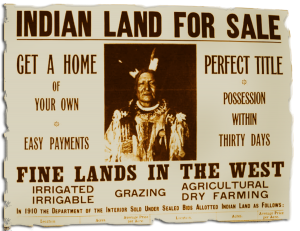
The last treaty the Senate ratified was with the Nez Perce, but it would not take long before the terms of that treaty were violated by white settlers with depredations to Indian lands that soon led to the Nez Perce Wars. –
No. Congress ended treaty-making with Indian tribes in 1871.
At the end of the treaty era, Native American tribes still controlled one-tenth of the contiguous 48 states, or about one-fourth of the land between the Mississippi and the Rocky Mountains.
In 1832 when United States Supreme Court ruled in Worster v. Georgia that the “several Indian nations” had legal status as “political communities within which their authority is exclusive.” On their reservations, created by treaties with the United States, Indians had exclusive authority, and this authority and all rights to land within the reservations were “not only acknowledged but guaranteed by the United States,” according to the court. Since then, relations with Indian groups have been formalized and/or codified by Congressional acts, Executive Orders, and Executive Agreements. Between 1778, when the first treaty was made with the Delawares, to 1871, when Congress ended the treaty-making period, the United States Senate ratified 370 treaties. At least 45 others were negotiated with tribes but were never ratified by the Senate. The treaties that were made often contain commitments that have either been fulfilled or subsequently superseded by Congressional legislation.
Treaties: , of course, were negotiated by the President and ratified by the Senate. Tiring of having to pay out annuities to tribes who signed treaties ratified by the U.S. Senate, the House demanded an end to the process through an amendment it attached to the appropriations bill of 1871 .
The specifics of particular treaties signed by government negotiators with Indian tribes are contained in one volume (Vol. II) of the publication, Indian Affairs, Laws and Treaties: 1778-1883, compiled, annotated, and edited by Charles J. Kappler. Published by the United States Government Printing Office in 1904, it is now out of print, but can be found in most large law libraries and on the Internet at http://digital.library.okstate.edu/Kappler. The treaty volume has also been published privately under the title, “Indian Treaties: 1778-1883.”
Originals of all the treaties are maintained by the National Archives and Records Administration of the General Services Administration. For more information on how to obtain copies or for more information about the treaties visit NARA’s website at www.nara.gov .
Kruechev said promises are made to be broken. The U.S. practiced this without saying it. Treaties are only as good as the integrity of he men who write them. It is the same with the constitution. It is being voided because it gives the people too much freedom. There are certain elements here that want to put the middle class and the beggars together in one community and call them equal. They are bent on destroying the church which is the cornerstone of stability. Most people will disagree with that statement, like the useful idiots and such. but , the unseen hand that guides the revolution knows and fights to kill all institutions that give a sense of belonging whether religious or secular. This is what this sort of agreement is for: to soothe the disenchanted til you get the upper hand.
There is a difference between two separate countries making treaties and an occupying power making powers over a sovereign people living in its borders.